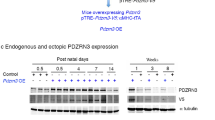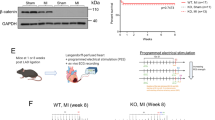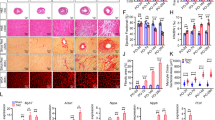Abstract
αE-catenin is a component of adherens junctions that link the cadherin-catenin complex to the actin cytoskeleton. The signaling function of this protein was recently revealed. In the present study, we investigated the role of αE-catenin in the pathogenesis of heart failure. We mated αE-catenin conditional knockout mice with αMHC-Cre mice and evaluated their mutant offspring. We found that αE-catenin knockout caused enlargement of the heart and atria, fibrosis, the upregulation of hypertrophic genes, and the dysregulation of fatty acid metabolism via the transcriptional activity of Yap and β-catenin. The activation of canonical Wnt and Yap decreased the activity of main regulators of energy metabolism (i.e., adenosine monophosphate-activated protein kinase and peroxisome proliferator-activated receptor α) and dysregulated hypertrophic pathway activity (i.e., phosphatidylinositide 3-kinase/Akt, cyclic adenosine monophosphate/protein kinase A, and MEK1/extracellular signal regulated kinase 1/2). The loss of αE-catenin also negatively affected cardio-hemodynamic function via the protein kinase A pathway. Overall, we found that the embryonic heart-specific ablation of αE-catenin leads to the development of heart failure with age and premature death in mice. Thus, αE-catenin appears to have a crucial signaling function in the postnatal heart, and the dysfunction of this gene causes heart failure through canonical Wnt and Yap activation.








Similar content being viewed by others
Change history
04 July 2018
The original version of this article unfortunately contained a mistake. The published paper presented an incorrect version of Table 1. The corrected Table is given here.
References
Agah R, Frenkel PA, French BA, Michael LH, Overbeek PA, Schneider MD (1997) Gene recombination in postmitotic cells. Targeted expression of Cre recombinase provokes cardiac-restricted, site-specific rearrangement in adult ventricular muscle in vivo. J Clin Invest 100:169–179. https://doi.org/10.1172/JCI119509
Ahuja P, Zhao P, Angelis E, Ruan H, Korge P, Olson A, Wang Y, Jin ES, Jeffrey FM, Portman M, Maclellan WR (2010) Myc controls transcriptional regulation of cardiac metabolism and mitochondrial biogenesis in response to pathological stress in mice. J Clin Invest 120:1494–1505. https://doi.org/10.1172/JCI38331
Armstrong S, Ganote CE (1994) Preconditioning of isolated rabbit cardiomyocytes: effects of glycolytic blockade, phorbol esters, and ischaemia. Cardiovasc Res 28:1700–1706. https://doi.org/10.1093/cvr/28.11.1700
Barry SP, Davidson SM, Townsend PA (2008) Molecular regulation of cardiac hypertrophy. Int J Biochem Cell Biol 40:2023–2039. https://doi.org/10.1016/j.biocel.2008.02.020
Baurand A, Zelarayan L, Betney R, Gehrke C, Dunger S, Noack C, Busjahn A, Huelsken J, Taketo MM, Birchmeier W, Dietz R, Bergmann MW (2007) β-catenin downregulation is required for adaptive cardiac remodeling. Circ Res 100:1353–1362. https://doi.org/10.1161/01.RES.0000266605.63681.5a
Bednarski T, Olichwier A, Opasinska A, Pyrkowska A, Gan A-M, Ntambi JM, Dobrzyn P (2016) Stearoyl-CoA desaturase 1 deficiency reduces lipid accumulation in the heart by activating lipolysis independently of peroxisome proliferator-activated receptor α. Biochim Biophys Acta - Mol Cell Biol Lipids 1861:2029–2037. https://doi.org/10.1016/j.bbalip.2016.10.005
Beitner-Johnson D, Rust RT, Hsieh TC, Millhorn DE (2001) Hypoxia activates Akt and induces phosphorylation of GSK-3 in PC12 cells. Cell Signal 13:23–27. https://doi.org/10.1016/S0898-6568(00)00128-5
van den Borne SWM, Narula J, Voncken JW, Lijnen PM, Vervoort-Peters HTM, Dahlmans VEH, Smits JFM, Daemen MJAP, Blankesteijn WM (2008) Defective intercellular adhesion complex in myocardium predisposes to infarct rupture in humans. J Am Coll Cardiol 51:2184–2192. https://doi.org/10.1016/j.jacc.2008.02.056
Brade T, Männer J, Kühl M (2006) The role of Wnt signalling in cardiac development and tissue remodelling in the mature heart. Cardiovasc Res 72:198–209. https://doi.org/10.1016/j.cardiores.2006.06.025
Breckenridge R (2010) Heart failure and mouse models. Dis Model Mech 3:138–143. https://doi.org/10.1242/dmm.005017
Breuleux M, Klopfenstein M, Stephan C, Doughty CA, Barys L, Maira S-M, Kwiatkowski D, Lane HA (2009) Increased AKT S473 phosphorylation after mTORC1 inhibition is rictor dependent and does not predict tumor cell response to PI3K/mTOR inhibition. Mol Cancer Ther 8:742–753. https://doi.org/10.1158/1535-7163.MCT-08-0668
Chaanine AH, Hajjar RJ (2011) AKT signalling in the failing heart. Eur J Heart Fail 13:825–829. https://doi.org/10.1093/eurjhf/hfr080
Chen J, Kubalak SW, Chien KR (1998) Ventricular muscle-restricted targeting of the RXRalpha gene reveals a non-cell-autonomous requirement in cardiac chamber morphogenesis. Development 10:1943–1949
Choi SH, Estarás C, Moresco JJ, Yates JR, Jones KA, Jones KA (2013) α-Catenin interacts with APC to regulate β-catenin proteolysis and transcriptional repression of Wnt target genes. Genes Dev 27:2473–2488. https://doi.org/10.1101/gad.229062.113
Clark GJ, Drugan JK, Rossman KL, Carpenter JW, Rogers-Graham K, Fu H, Der CJ, Campbell SL (1997) 14-3-3 ζ negatively regulates Raf-1 activity by interactions with the Raf-1 cysteine-rich domain. J Biol Chem 272:20990–20993. https://doi.org/10.1074/jbc.272.34.20990
Dai Z, Aoki T, Fukumoto Y, Shimokawa H (2012) Coronary perivascular fibrosis is associated with impairment of coronary blood flow in patients with non-ischemic heart failure. J Cardiol 60:416–421. https://doi.org/10.1016/j.jjcc.2012.06.009
Dirkx E, da Costa Martins PA, De Windt LJ (2013) Regulation of fetal gene expression in heart failure. Biochim Biophys Acta - Mol Basis Dis 1832:2414–2424. https://doi.org/10.1016/J.BBADIS.2013.07.023
Dyck JRB, Lopaschuk GD (2006) AMPK alterations in cardiac physiology and pathology: enemy or ally? J Physiol 574:95–112. https://doi.org/10.1113/jphysiol.2006.109389
Fischer AH, Jacobson KA, Rose J, Zeller R (2008) Cryosectioning tissues. CSH Protoc 2008:pdb.prot4991. https://doi.org/10.1101/PDB.PROT4991
Fuchs AK, E (2008) α-CATENIN: at the junction of intercellular adhesion and actin dynamics. Nat Rev Mol Cell Biol 5:614–625
Fukuda N, Wu Y, Nair P, Granzier HL (2005) Phosphorylation of titin modulates passive stiffness of cardiac muscle in a titin isoform-dependent manner. J Gen Physiol 125:257–271. https://doi.org/10.1085/jgp.200409177
Gandhi MS, Kamalov G, Shahbaz AU, Bhattacharya SK, Ahokas RA, Sun Y, Gerling IC, Weber KT (2011) Cellular and molecular pathways to myocardial necrosis and replacement fibrosis. Heart Fail Rev 16:23–34. https://doi.org/10.1007/s10741-010-9169-3
Giannini AL, Vivanco M d M, Kypta RM (2000) α-Catenin inhibits β-catenin signaling by preventing formation of a β-catenin*t-cell factor*DNA complex. J Biol Chem 275:21883–21888. https://doi.org/10.1074/jbc.M001929200
Hasham MG, Baxan N, Stuckey DJ, Branca J, Perkins B, Dent O, Duffy T, Hameed TS, Stella SE, Bellahcene M, Schneider MD, Harding SE, Rosenthal N, Sattler S (2017) Systemic autoimmunity induced by the TLR7/8 agonist Resiquimod causes myocarditis and dilated cardiomyopathy in a new mouse model of autoimmune heart disease. Dis Model Mech 10:259–270. https://doi.org/10.1242/dmm.027409
Heallen T, Zhang M, Wang J, Bonilla-Claudio M, Klysik E, Johnson RL, Martin JF (2011) Hippo pathway inhibits Wnt signaling to restrain cardiomyocyte proliferation and heart size. Science (80- ) 332:458–461. https://doi.org/10.1126/science.1199010
Hirschy A, Croquelois A, Perriard E, Schoenauer R, Agarkova I, Hoerstrup SP, Taketo MM, Pedrazzini T, Perriard J-C, Ehler E (2010) Stabilised beta-catenin in postnatal ventricular myocardium leads to dilated cardiomyopathy and premature death. Basic Res Cardiol 105:597–608. https://doi.org/10.1007/s00395-010-0101-8
Horman S, Vertommen D, Heath R, Neumann D, Mouton V, Woods A, Schlattner U, Wallimann T, Carling D, Hue L, Rider MH (2006) Insulin antagonizes ischemia-induced Thr172 phosphorylation of AMP-activated protein kinase alpha-subunits in heart via hierarchical phosphorylation of Ser485/491. J Biol Chem 281:5335–5340. https://doi.org/10.1074/jbc.M506850200
Hou N, Ye B, Li X, Margulies KB, Xu H, Wang X, Li F (2016) Transcription factor 7-like 2 mediates canonical Wnt/β-catenin signaling and c-myc upregulation in heart failure. Circ Hear Fail 9. https://doi.org/10.1161/CIRCHEARTFAILURE.116.003010
Jamora C, Fuchs E (2002) Intercellular adhesion, signalling and the cytoskeleton. Nat Cell Biol 4:E101–E108. https://doi.org/10.1038/ncb0402-e101
Kass DA, Maughan WL, Guo ZM, Kono A, Sunagawa K, Sagawa K (1987) Comparative influence of load versus inotropic states on indexes of ventricular contractility: experimental and theoretical analysis based on pressure-volume relationships. Circulation 76:1422–1436
Kontaridis MI, Geladari EV, Geladari CV (2015) Pathways to myocardial hypertrophy. In: introduction to translational. Cardiovasc Res:167–186
Krüger M, Linke WA (2006) Protein kinase-A phosphorylates titin in human heart muscle and reduces myofibrillar passive tension. J Muscle Res Cell Motil 27:435–444. https://doi.org/10.1007/s10974-006-9090-5
Lee C-Y, Kuo WW, Baskaran R, Day CH, Pai PY, Lai CH, Chen Y-F, Chen R-J, Padma VV, Huang CY (2017) Increased β-catenin accumulation and nuclear translocation are associated with concentric hypertrophy in cardiomyocytes. Cardiovasc Pathol 31:9–16. https://doi.org/10.1016/j.carpath.2017.07.003
Li J, Gao E, Vite A, Yi R, Gomez L, Goossens S, Van Roy F, Radice GL (2015) Alpha-catenins control cardiomyocyte proliferation by regulating yap activity. Circ Res 116:70–79. https://doi.org/10.1161/CIRCRESAHA.116.304472
Light Y, Paterson H, Marais R (2002) 14-3-3 antagonizes Ras-mediated Raf-1 recruitment to the plasma membrane to maintain signaling fidelity. 22:4984–4996. doi: https://doi.org/10.1128/MCB.22.14.4984
Ljungberg O, Tibblin S (1979) Peroperative fat staining of frozen sections in primary hyperparathyroidism. Am J Pathol 95:633–641
Lyons GE, Schiaffino S, Sassoon D, Barton P, Buckingham M (1990) Developmental regulation of myosin gene expression in mouse cardiac muscle. J Cell Biol 111:2427–2436
Mazurek JA, Jessup M (2015) Understanding heart failure. Card Electrophysiol Clin 7:557–575. https://doi.org/10.1016/j.ccep.2015.08.001
Olinde MDKD, O’Connell MDJB (1994) Inflammatory heart disease: pathogenesis, clinical manifestations, and treatment of myocarditis. Annu Rev Med 45:481–490. https://doi.org/10.1146/annurev.med.45.1.481
Padala RR, Karnawat R, Viswanathan SB, Thakkar AV, Das AB, Hanna S, Peifer M, Brugge JS, Moses TY, Savage S, Uhlik M, Lin A, Du J, Qian YW, Zeckner DJ, Tucker-Kellogg G, Touchman J, Patel K, Mousses S, Bittner M, Schevitz R, Lai MH, Blanchard KL, Thomas JE, Hooper S, Wilson R, Jayatilake H, Gusterson BA, Cooper C, Shipley J, Hargrave D, Pritchard-Jones K, Maitland N, Chenevix-Trench G, Riggins GJ, Bigner DD, Palmieri G, Cossu A, Flanagan A, Nicholson A, Ho JW, Leung SY, Yuen ST, Weber BL, Seigler HF, Darrow TL, Paterson H, Marais R, Marshall CJ, Wooster R, Stratton MR, Futreal PA (2017) Cancerous perturbations within the ERK, PI3K/Akt, and Wnt/β-catenin signaling network constitutively activate inter-pathway positive feedback loops. Mol BioSyst 13:830–840. https://doi.org/10.1039/C6MB00786D
Piven OO, Kostetskii IE, Macewicz LL, Kolomiets YM, Radice GL, Lukash LL (2011) Requirement for N-cadherin-catenin complex in heart development. Exp Biol Med (Maywood) 236:816–822. https://doi.org/10.1258/ebm.2011.010362
Purcell NH, Wilkins BJ, York A, Saba-El-Leil MK, Meloche S, Robbins J, Molkentin JD (2007) Genetic inhibition of cardiac ERK1/2 promotes stress-induced apoptosis and heart failure but has no effect on hypertrophy in vivo. Proc Natl Acad Sci U S A 104:14074–14079. https://doi.org/10.1073/pnas.0610906104
Qi D, Young LH (2015) AMPK: energy sensor and survival mechanism in the ischemic heart. Trends Endocrinol Metab 26:422–429. https://doi.org/10.1016/j.tem.2015.05.010
Rose BA, Force T, Wang Y (2010) Mitogen-activated protein kinase signaling in the heart: angels versus demons in a heart-breaking tale. Physiol Rev 90:1507–1546. https://doi.org/10.1152/physrev.00054.2009
Schlegelmilch K, Mohseni M, Kirak O, Pruszak J, Rodriguez JRR, Zhou D, Kreger BTT, Vasioukhin V, Avruch J, Brummelkamp TRR, Camargo FDD (2011) Yap1 acts downstream of α-catenin to control epidermal proliferation. Cell 144:782–795. https://doi.org/10.1016/j.cell.2011.02.031
Schneider CA, Rasband WS, Eliceiri KW (2012) NIH image to ImageJ: 25 years of image analysis. Nat Methods 9:671–675. https://doi.org/10.1038/nmeth.2089
Sheikh F, Chen Y, Liang X, Hirschy A, Stenbit AE, Gu Y, Dalton ND, Yajima T, Lu Y, Knowlton KU, Peterson KL, Perriard JC, Chen J (2006) α-E-catenin inactivation disrupts the cardiomyocyte adherens junction, resulting in cardiomyopathy and susceptibility to wall rupture. Circulation 114:1046–1055. https://doi.org/10.1161/CIRCULATIONAHA.106.634469
Silvis MR, Kreger BT, Lien W-H, Klezovitch O, Rudakova GM, Camargo FD, Lantz DM, Seykora JT, Vasioukhin V (2011) α-catenin is a tumor suppressor that controls cell accumulation by regulating the localization and activity of the transcriptional coactivator Yap1. Sci Signal 4:ra33. https://doi.org/10.1126/scisignal.2001823
Stepniak E, Radice GL, Vasioukhin V (2009) Adhesive and signaling functions of cadherins and catenins in vertebrate development. Cold Spring Harb Perspect Biol 1:a002949. https://doi.org/10.1101/cshperspect.a002949
Taegtmeyer H, Sen S, Vela D (2010) Return to the fetal gene program: a suggested metabolic link to gene expression in the heart. Ann N Y Acad Sci 1188:191–198. https://doi.org/10.1111/j.1749-6632.2009.05100.x
Thorson JA, Yu LW, Hsu AL, Shih NY, Graves PR, Tanner JW, Allen PM, Piwnica-Worms H, Shaw AS (1998) 14-3-3 proteins are required for maintenance of Raf-1 phosphorylation and kinase activity. Mol Cell Biol 18:5229–5238. https://doi.org/10.1128/MCB.18.9.5229
Torres M, Stoykova A, Huber O, Chowdhury K, Bonaldo P, Mansouri A, Butz S, Kemler R, Gruss P (1997) An alpha-E-catenin gene trap mutation defines its function in preimplantation development. Proc Natl Acad Sci U S A 94:901–906. https://doi.org/10.1073/pnas.94.3.901
Vasioukhin V, Bauer C, Degenstein L, Wise B, Fuchs E (2001) Hyperproliferation and defects in epithelial polarity upon conditional ablation of α-catenin in skin. Cell 104:605–617. https://doi.org/10.1016/S0092-8674(01)00246-X
Wickline ED, Dale IW, Merkel CD, Heier JA, Stolz DB, Kwiatkowski AV (2016) αT-catenin is a constitutive actin-binding α-catenin that directly couples the cadherin·catenin complex to actin filaments. J Biol Chem 291:15687–15699. https://doi.org/10.1074/jbc.M116.735423
Yang G, Murashige DS, Humphrey SJ, James DE (2015) A positive feedback loop between Akt and mTORC2 via SIN1 phosphorylation. Cell Rep 12:937–943. https://doi.org/10.1016/j.celrep.2015.07.016
Yeaman SJ (1990) Hormone-sensitive lipase—a multipurpose enzyme in lipid metabolism. Biochim Biophys Acta - Mol Cell Res 1052:128–132. https://doi.org/10.1016/0167-4889(90)90067-N
Yonemura S, Wada Y, Watanabe T, Nagafuchi A, Shibata M (2010) alpha-Catenin as a tension transducer that induces adherens junction development. Nat Cell Biol 12:533–542. https://doi.org/10.1038/ncb2055
Yun M, Kim S, Jeon SH, Lee J, Choi K (2005) Both ERK and Wnt/beta-catenin pathways are involved in Wnt3a-induced proliferation. J Cell Sci 118:313–322. https://doi.org/10.1242/jcs.01601
Zhang Y, Del Re DP (2017) A growing role for the Hippo signaling pathway in the heart. J Mol Med 95:465–472
Zhou Q, Li L, Zhao B, Guan K-L (2015) The Hippo pathway in heart development, regeneration, and diseases. Circ Res 116:1431–1447. https://doi.org/10.1161/CIRCRESAHA.116.303311
Acknowledgements
We thank Dr. Glenn Radice, Thomas Jefferson University, for providing αMHC-Cre and αE-catenin animals. We also thank Lesya V. Tumanovska, MSc, Bogomoletz Institute of Physiology, National Academy of Sciences of Ukraine, for assistance with the cryosection preparations. This study was supported by a Joint Research Project under a scientific cooperation agreement between the Polish Academy of Science and National Academy of Sciences of Ukraine (2015-2017). OOP was supported by the National Academy of Sciences of Ukraine (N40/2015-2020). PD and AMG were supported by grants from the National Science Centre, Poland (UMO-2014/13/B/NZ4/00199, UMO-2016/22/E/NZ4/00650, and UMO-2015/17/D/NZ5/03446). VN was supported by the European Union’s Horizon 2020 research and innovation program under Marie Sklodowska-Curie grant agreement no. 665735 (Bio4Med) and by funding from the Polish Ministry of Science and Higher Education as part of 2016-2020 funds for the implementation of international projects (agreement no. 3548/H2020/COFUND/2016/2).
Author information
Authors and Affiliations
Contributions
All of the authors participated in the design of the study and interpretation and analysis of the data and reviewed of the manuscript. PD, VD, and OOP planned the experiments, discussed the results, and wrote the manuscript. VVB and LLM were involved in the generation of transgenic mice and genotyping, conducted the morphological analysis, performed qPCR, and performed the statistical analysis. AMG, PP, VON, and AO performed the protein isolation and Western blot analysis. SG, GP, and TLB measured and statistically analyzed the cardio-hemodynamic parameters.
Corresponding author
Ethics declarations
Competing interests
The authors declare that they do not have any competing or financial interests.
Rights and permissions
About this article
Cite this article
Balatskyi, V.V., Macewicz, L.L., Gan, AM. et al. Cardiospecific deletion of αE-catenin leads to heart failure and lethality in mice. Pflugers Arch - Eur J Physiol 470, 1485–1499 (2018). https://doi.org/10.1007/s00424-018-2168-2
Received:
Revised:
Accepted:
Published:
Issue Date:
DOI: https://doi.org/10.1007/s00424-018-2168-2




